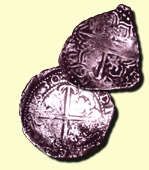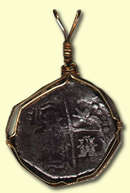
|
Silverbank Treasure Coins
Visit the Interactive Silver Bank feature on the National Geographic Society Web Site. The History of the Coins Coins of the Spanish-American Colonial Mints (often called "COBS") were very irregular due to the manner in which they were made. It is believed that no two were ever made exactly alike. The prescribed weight of the 8-real coin, the full unit of measure of the time, was 27.4680 grams of almost-pure (90% or better) silver. Although the majority of the coins produced were 8-reals (called "pieces of eight"),  denominations of 4, 2, 1 and 1/2 were also minted, and each was supposed to be one-half the weight of the next largest denomination. Naturally, after 350 years under the sea, most of the Silver Bank coins vary from their prescribed weight.(For an informative book about Spanish-American silver coins, see "The Practical Book of COBS" by Daniel Sedwick and Frank Sedwick, Third Edition.) denominations of 4, 2, 1 and 1/2 were also minted, and each was supposed to be one-half the weight of the next largest denomination. Naturally, after 350 years under the sea, most of the Silver Bank coins vary from their prescribed weight.(For an informative book about Spanish-American silver coins, see "The Practical Book of COBS" by Daniel Sedwick and Frank Sedwick, Third Edition.) The COBS were made by cutting blanks from a piece of silver of the approximate desired weight from slabs of refined silver, then pared down to the exact weight using shears or a chisel, or both. The blank was then heated and placed between two metal dies (for both sides of the coin) and struck hard once or twice with a heavy hammer. The resulting impression was normally blurry and missing part of the image. Mostly the date (like "1641") and the name of the ruling monarch (like "Phillip IV"), which were on the outside edges of the coin, were missing or only partially there. Some coins were better struck than others. No two were identical and therein lies their uniqueness. As the Concepción was coming from Vera Cruz, Mexico, most of the recovered coins were minted in Mexico, but a small number of these coins were transhipped from South America and came from the Potosí mint, in present day Bolivia. Both of the coin styles represent the artistry of their mint engravers from centuries past. Since upon reaching Spain, most of these coins were melted down to produce more modern coins, few have survived the passage of time. All of the offered coins are from 1641 or earlier and are from the reigns of the Spanish kings; Phillip III, and Phillip IV. |
